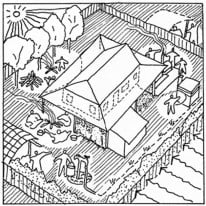B5 - Reducing the negative impacts of crowding

Crowded living conditions, the close proximity of a group of people, increase the risk of the spread of infectious diseases, such as respiratory infections, meningococcal disease, rheumatic fever and tuberculosis.
The better planning of the house and the surrounding living environment can reduce crowding, and access to functioning health hardware, such as hot water, showers and clothes washing facilities, can reduce the health impacts of crowding.
Crowding of a house may be a regular, temporary and desirable event. A party, ceremony or sports carnival may all be important cultural events involving large numbers of people. This should not be confused with long term, involuntary crowding together of one large family into a very small house or several families into one house due to lack of available housing or poverty.
At the beginning of any housing project, estimate the number of people likely to be using the houses, especially at peak times. This can be difficult to calculate when there is a general lack of housing in the surrounding community and people need to share the resources that any functioning house can provide. The number of bedrooms, square metre area of the house or housing management rules may not be a good indicator of the future population of the house.
As the following example shows, estimated population per house cannot be calculated by simply dividing a community’s population by the number of houses in the community.
In a community with 300 people and 50 houses, it could be assumed that an average of six people live in each house. Consultation with the community may reveal that only 25 of the 50 houses have health hardware working, and residents of the ‘non-functional’ houses have to use the houses in which health hardware is working, which means the average house population would be 12 people. If a sports carnival is held in the community or during the annual wet season (when lack of easy access to smaller surrounding communities is stopped by flooded roads and people relocate to the main towns for 3-4 months), the population could double or treble and the demand on working houses to could increase to 24 – 36 people per house.
Beware of estimating house population by dividing the community population by house numbers because this could mean that houses will not be designed to have sufficient space and health hardware, and the residents will experience increased health risks.
It is also possible that specific parts of a house can become crowded at particular times. For example, in extreme climatic conditions, all members of the household are likely to congregate in the one room of the house that can be cooled or heated and this can lead to the increased spread of infection, even in small households.
Even if all houses in a community are fully functional, some families will choose to live in large, multi-generational households. These families will not necessarily consider their house to be crowded, but could suffer health effects if the health hardware is not adequate for the number of people living in the house. A large household population can also cause health hardware to fail prematurely simply because it is used more.
Many people using a house may lead to high power bills and the choice between making rental payments, buying food or paying for power. Lack of power may mean losing access to all the health hardware services provided by the house and a greater health impact. Therefore, energy efficiency, in house design and specification, should be seen as playing an important part in reducing crowding and maintaining health.
More houses may reduce the negative impacts of Crowding, however the example above shows that it is also necessary to design for peak populations. This can be achieved by providing more health hardware in houses, ensuring access is possible to the health hardware, developing the yard and edges of houses to provide more household service, cooling and heating several rooms in the house, providing additional sleeping areas for guests, and ensuring the health hardware in most houses in a community is functioning most of the time through regular maintenance.
